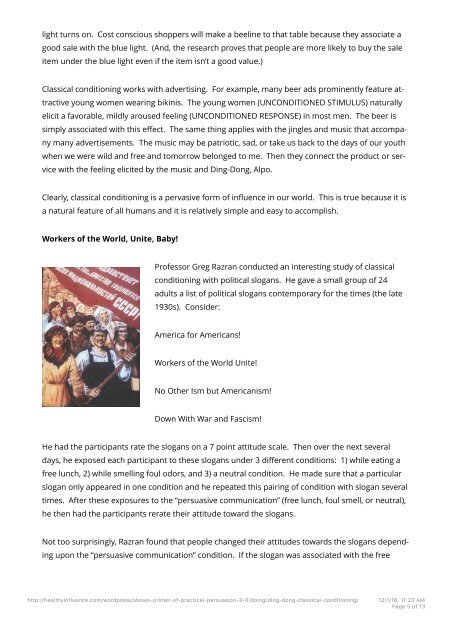Classical Conditioning _ Persuasion Blog
Create successful ePaper yourself
Turn your PDF publications into a flip-book with our unique Google optimized e-Paper software.
light turns on. Cost conscious shoppers will make a beeline to that table because they associate a<br />
good sale with the blue light. (And, the research proves that people are more likely to buy the sale<br />
item under the blue light even if the item isn’t a good value.)<br />
<strong>Classical</strong> conditioning works with advertising. For example, many beer ads prominently feature attractive<br />
young women wearing bikinis. The young women (UNCONDITIONED STIMULUS) naturally<br />
elicit a favorable, mildly aroused feeling (UNCONDITIONED RESPONSE) in most men. The beer is<br />
simply associated with this effect. The same thing applies with the jingles and music that accompany<br />
many advertisements. The music may be patriotic, sad, or take us back to the days of our youth<br />
when we were wild and free and tomorrow belonged to me. Then they connect the product or service<br />
with the feeling elicited by the music and Ding-Dong, Alpo.<br />
Clearly, classical conditioning is a pervasive form of influence in our world. This is true because it is<br />
a natural feature of all humans and it is relatively simple and easy to accomplish.<br />
Workers of the World, Unite, Baby!<br />
Professor Greg Razran conducted an interesting study of classical<br />
conditioning with political slogans. He gave a small group of 24<br />
adults a list of political slogans contemporary for the times (the late<br />
1930s). Consider:<br />
America for Americans!<br />
Workers of the World Unite!<br />
No Other Ism but Americanism!<br />
Down With War and Fascism!<br />
He had the participants rate the slogans on a 7 point attitude scale. Then over the next several<br />
days, he exposed each participant to these slogans under 3 different conditions: 1) while eating a<br />
free lunch, 2) while smelling foul odors, and 3) a neutral condition. He made sure that a particular<br />
slogan only appeared in one condition and he repeated this pairing of condition with slogan several<br />
times. After these exposures to the “persuasive communication” (free lunch, foul smell, or neutral),<br />
he then had the participants rerate their attitude toward the slogans.<br />
Not too surprisingly, Razran found that people changed their attitudes towards the slogans depending<br />
upon the “persuasive communication” condition. If the slogan was associated with the free<br />
http://healthyinfluence.com/wordpress/steves-primer-of-practical-persuasion-3-0/doing/ding-dong-classical-conditioning/<br />
12/1/16, 11@23 AM<br />
Page 5 of 13



